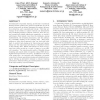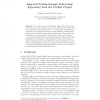426 search results - page 85 / 86 » The Distribution of Patterns in Random Trees |
KDD
2005
ACM
14 years 7 months ago
2005
ACM
Discriminative sequential learning models like Conditional Random Fields (CRFs) have achieved significant success in several areas such as natural language processing, information...
JCB
2006
13 years 6 months ago
2006
We propose a dictionary model for haplotypes. According to the model, a haplotype is constructed by randomly concatenating haplotype segments from a given dictionary of segments. ...
TAICPART
2010
IEEE
13 years 5 months ago
2010
IEEE
We report on how the Wrangler refactoring tool has been used to improve and transform test code for Erlang systems. This has been achieved through the removal of code clones, the i...
GECCO
2010
Springer
13 years 11 months ago
2010
Springer
Negative selection algorithms are immune-inspired classifiers that are trained on negative examples only. Classification is performed by generating detectors that match none of ...
CN
2010
13 years 6 months ago
2010
The dynamic point coverage problem in wireless sensor networks is to detect some moving target points in the area of the network using as little sensor nodes as possible. One way ...


